Mumbai: The growth of currency in circulation (CIC) has seen a sharp rise to 9.8 per cent in the 2020-21 fiscal so far as compared to 2.6 per cent in the same year-ago period. The year-on-year CIC growth was 22.6 per cent as of 4 September as compared to 13 per cent on the day last year, latest data from the Reserve Bank of India showed.
This rise is also evident when the growth is compared with the end-March 2020 figures, when year-on-year CIC growth was 14 per cent.
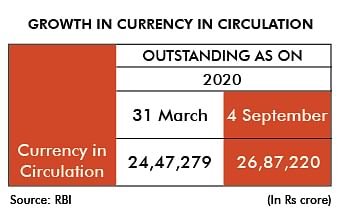
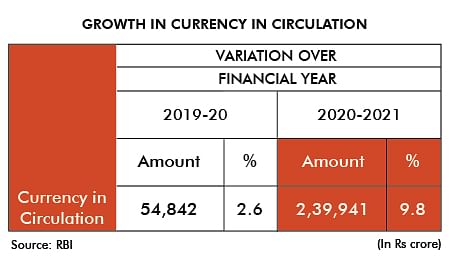
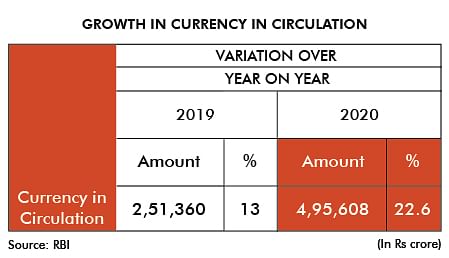
According to experts, an increase in currency in circulation means people are holding on to more cash since the nationwide lockdown, which was implemented in March to curb the spread of Covid-19 infections. During uncertain times like these, there is a tendency among people to hold cash which gives them a sense of security.
“The increase in currency in circulation is indicative of the fact that people still like cash as a precautionary measure. During uncertain times, people tend to hold more currency because it gives them security,” said Madan Sabnavis, chief economist, Care Ratings.
“Whenever there are uncertain times, like we are seeing now, there is uncertainty about the future, people tend to hold currency. Simultaneously there has been an increase in digital transactions. The number of card transactions, mobile wallet transactions have also gone up,” Sabnavis told ThePrint.
Typically, currency in circulation goes up during a period of high economic growth. However, that was not the case this time around.
“Rise in currency circulation FYTD (financial year till date) has been likely driven by precautionary motives or to reduce frequency of visits to ATMs/banks to draw cash amidst the ongoing pandemic. The usual positive correlation between higher currency in circulation and nominal GDP growth has broken this time,” said Anubhuti Sahay, head of South Asia Economic Research, Standard Chartered Bank.
The nationwide lockdown has pushed the country in a recession as economic growth for the current financial year is seen in the negative zone. Real GDP for the first quarter of the ongoing fiscal contracted by 23.4 per cent.
According to bankers, precautionary demand for cash has gone up substantially, which is double the amount of last year. What has surprised them is the fact that not only households, but companies are also sitting on cash.
“The companies are not investing in capital… They are just sitting on cash. They are preserving cash by not paying their vendors, suppliers,” said a senior official from a large public sector bank who didn’t wish to be named.
The advanced economies are also experiencing this ‘dash for cash’ phenomenon following the outbreak of the Covid-19 pandemic where investors are resorting to stock up their cash by selling liquid assets.
Also read: Modi didn’t favour issuing of Rs 2,000 notes, went along with consensus, reveals ex-aide Misra
High demand for Rs 2000 note
Even before the pandemic, there has been high demand for the Rs 2,000 currency note, bankers said. This has led RBI to withdraw some of the Rs 2,000 notes from circulation that resulted in a fall in the volume of that particular denomination in FY20 as compared to the previous year.
There were 27,398 lakh pieces of Rs 2,000 denomination note in FY20 which constituted 2.4 per cent of the total volume. In 2018-19, there were 32,910 lakh pieces of Rs 2,000 note which was 3 per cent of the total notes in circulation in terms of volume.
The trend of Rs 2,000 note is in sharp contrast with other denomination bank notes.
The Rs 500 note, for example, constituted 25.4 per cent of the total circulation by volume in FY20, up from 19.8 per cent in the previous year.
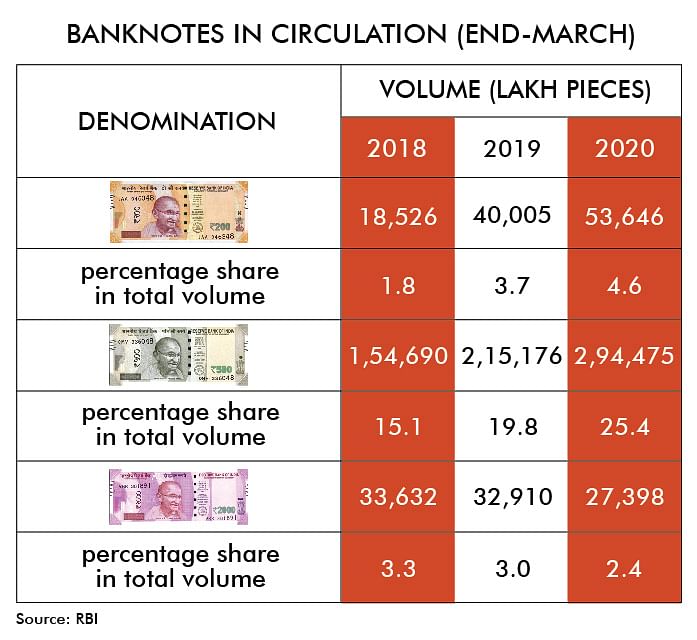
The value and volume of banknotes in circulation increased by 14.7 per cent, and 6.6 per cent, respectively, during 2019-20.
In value terms, the share of Rs 500 and Rs 2,000 banknotes together accounted for 83.4 per cent of the total circulation at end-March 2020, with a sharp increase in the share of Rs 500 banknotes, RBI had said in its annual report for FY20.
The Rs 2,000 banknote was issued after the demonetisation exercise of November 2016 in which the old series Rs 500 note and the Rs 1,000 note was withdrawn from circulation.
Bankers said the demand for Rs 2,000 note has surged. Ironically, one of Narendra Modi government’s stated reasons behind demonetisation was to reduce cash demand.
Another reason was to unearth black money. Bankers said the central bank may have economised the Rs 2,000 notes while increasing the supply of smaller currency notes as there could be a possibility of hoarding of Rs 2,000 rupee note.
Also read: India’s economic recovery to be gradual, says RBI Governor Shaktikanta Das


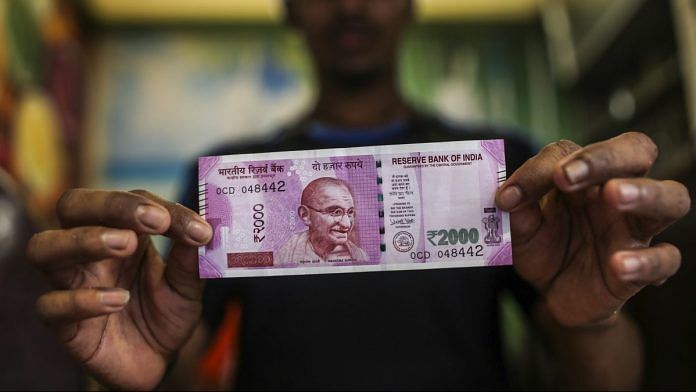

Meanwhile, smart Gujaratis are quietly moving their assets to Switzerland, UK, Germany and so on … The next generation of Mehul Choksis, Nirav Modis, Lalit Modis are smarter than ever. And the likes of A.Raja are mere amateurs compared with the Gujarati wheeler dealers …
And meanwhile, the middle class continues to support the flawed, bigoted man who sígns their death warrants …
This chai wala is bent on hell to destroy the common man.
Bound to be black money under the mattresses. We need another 8 pm address by Modi ji announcing next surgical strike of demonitization. Modi hai to….
Serious or joking!